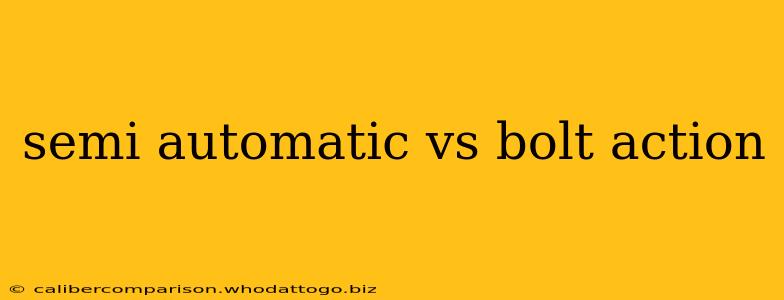Choosing between a semi-automatic and a bolt-action rifle is a crucial decision for any shooter, whether you're a seasoned hunter, a competitive marksman, or a dedicated hobbyist. Both offer unique advantages and disadvantages, making the "best" choice highly dependent on your specific needs and preferences. This in-depth comparison will help you understand the key differences and make an informed decision.
Speed and Rate of Fire
This is perhaps the most significant difference. Semi-automatic rifles utilize the energy from the fired cartridge to automatically cycle the action, reloading the next round. This allows for a much faster rate of fire, crucial in situations requiring rapid follow-up shots. Think self-defense or certain hunting scenarios where quick, accurate shots on multiple targets are vital.
Bolt-action rifles, on the other hand, require manual operation. After each shot, the shooter must manually work the bolt to extract the spent casing and chamber a new round. This process is inherently slower, limiting the rate of fire. However, this slower pace often encourages more deliberate aiming and shot placement.
Accuracy and Precision
While both types of rifles can achieve exceptional accuracy, there are subtle differences. The slower, more deliberate nature of bolt-action rifles often contributes to higher levels of precision for many shooters. The time taken between shots allows for better target reacquisition and more careful aiming.
Semi-automatic rifles, due to their faster cycling, can be slightly more susceptible to recoil influencing subsequent shots, particularly for less experienced shooters. However, advancements in modern semi-automatic designs, including adjustable stocks and recoil mitigation systems, are narrowing this gap considerably. High-quality semi-automatic rifles can achieve remarkable accuracy.
Reliability and Maintenance
Both bolt-action and semi-automatic rifles are generally reliable, but their maintenance requirements differ. Bolt-action rifles typically have simpler mechanisms with fewer moving parts, resulting in less frequent maintenance needs. Cleaning and lubrication are straightforward.
Semi-automatic rifles, with their more complex mechanisms, require more meticulous cleaning and lubrication to maintain optimal function and reliability. Failure to properly maintain a semi-automatic rifle can lead to malfunctions more readily than with a comparable bolt-action.
Cost and Affordability
The cost spectrum for both types of rifles is quite broad, spanning from budget-friendly options to high-end, precision-engineered models. Generally, entry-level bolt-action rifles tend to be slightly more affordable than comparable semi-automatic rifles. However, as you move into higher-end models, the price difference can become less pronounced.
Ammunition Consumption
A significant consideration is ammunition usage. The rapid fire capability of semi-automatic rifles leads to a considerably higher rate of ammunition consumption compared to bolt-action rifles. This is a key factor for hunters and target shooters who need to manage their ammunition budget carefully.
Applications: Where Each Excels
-
Bolt-Action Rifles: Ideal for long-range precision shooting, hunting applications requiring precise shot placement (big game hunting), and situations where ammunition conservation is crucial. Their inherent simplicity and reliability make them a favored choice in challenging environments.
-
Semi-Automatic Rifles: Best suited for applications requiring rapid follow-up shots, self-defense, tactical situations, and hunting scenarios involving multiple targets or close-range encounters.
Conclusion
The choice between a semi-automatic and a bolt-action rifle hinges on individual needs and priorities. There's no universally "better" option. Consider your intended use, shooting style, budget, and maintenance preferences carefully to determine which type of rifle best suits your requirements. Both offer excellent performance, but their strengths lie in different areas.

